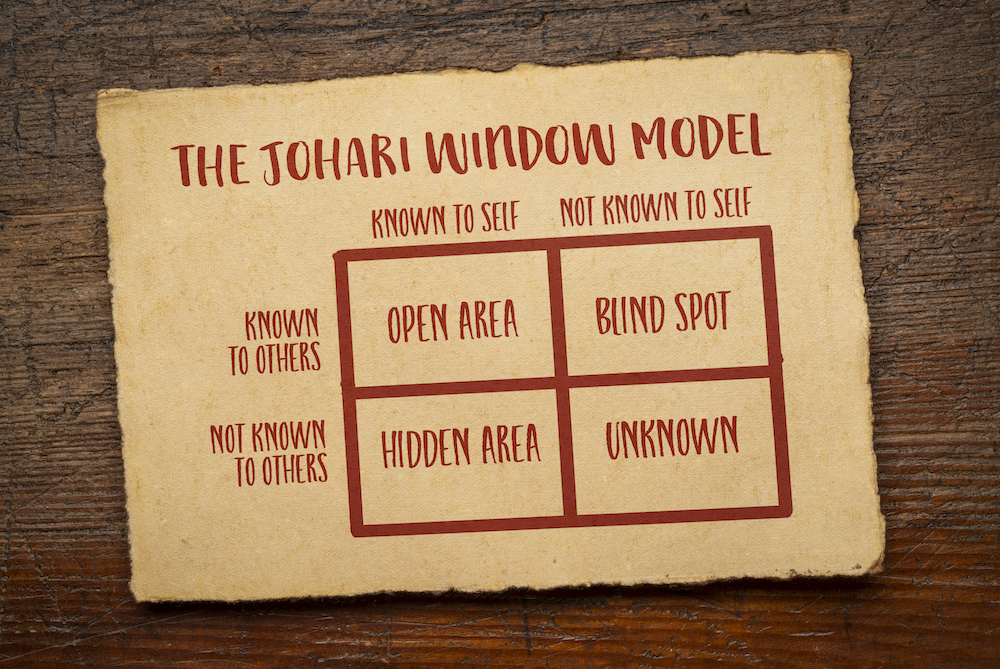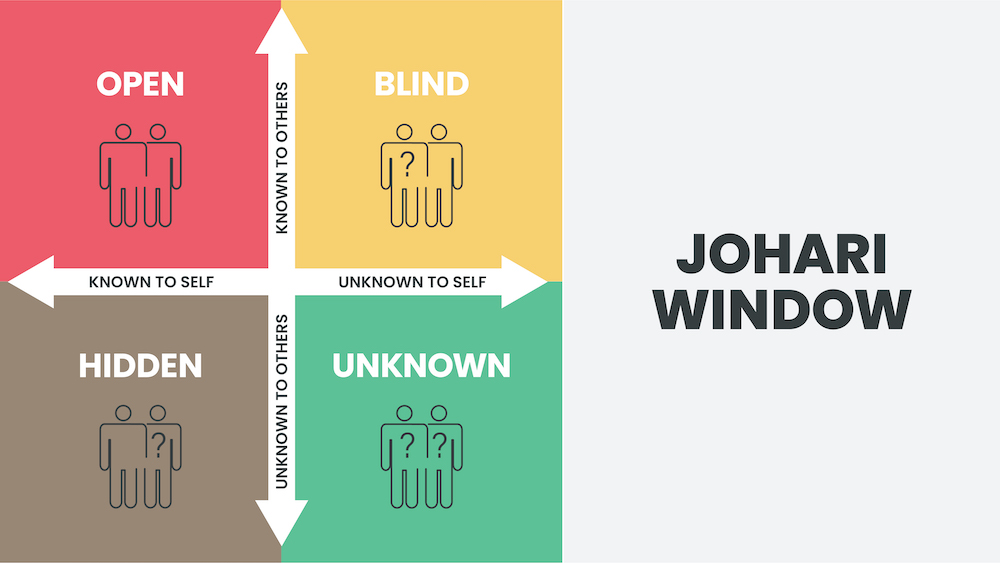Have you heard the expression “you don’t know what you don’t know?” Or, are you trying to understand the “unknown unknowns” to help yourself develop or make better decisions in your work? The Johari Window is a framework that can shed light on this concept.
As organizations continue to evolve and change, it is becoming increasingly important for individuals to develop their leadership skills and increase their self-awareness. One of the most widely used models for increasing self-awareness is the Johari Window. In this training guide, we will explain what the Johari Window is, how it can be applied in an organizational setting, and provide examples to help individuals accelerate their learning, develop their leadership skills, and innovate within their organization.
What is the Johari Window?
The Johari Window is a model that was developed by Joseph Luft and Harry Ingham in the 1950s. It is designed to increase self-awareness and improve communication between individuals by breaking down the different aspects of an individual’s personality into four quadrants. The four quadrants are as follows:
- The Open Self This quadrant represents the knowledge, skills, and behaviors that are known to both the individual and others. For example, an individual who is skilled in project management and communicates well with others may have these skills in their open self quadrant.
- The Hidden Self This quadrant represents the knowledge, skills, and behaviors that are known to the individual but not to others. For example, an individual who has a talent for graphic design but has not shared this with their team may have this skill in their hidden self quadrant.
- The Blind Self This quadrant represents the knowledge, skills, and behaviors that are known to others but not to the individual. For example, an individual who interrupts others during meetings may not be aware of this behavior, but their colleagues are.
- The Unknown Self This quadrant represents the knowledge, skills, and behaviors that are unknown to both the individual and others. For example, an individual may not know that they have a talent for public speaking until they are given the opportunity to speak at a company event.
By understanding these different quadrants, individuals can work to increase their self-awareness and improve their communication and relationships with others.

Application of the Johari Window in an Organizational Setting
The Johari Window can be applied in an organizational setting to improve communication and increase self-awareness among employees. By using the Johari Window model, employees can better understand their strengths and weaknesses and work to improve their communication with others. The model can be used in the following ways:
- Increasing Self-Awareness: By understanding the different quadrants of the Johari Window, employees can identify their strengths and weaknesses and work to improve their communication with others. For example, an employee who has a tendency to interrupt others during meetings may not be aware of this behavior. By understanding the blind self quadrant, the employee can work to improve their communication skills and reduce this behavior.
- Improving Communication: The Johari Window can be used to improve communication between employees by increasing their awareness of their own behavior and the behavior of others. For example, an employee who is aware of their own communication style may be able to adapt their style to better communicate with others who have different styles.
- Building Trust: By increasing self-awareness and improving communication, the Johari Window can help to build trust among employees. When individuals feel that they are understood and that their strengths and weaknesses are recognized, they are more likely to trust their colleagues and work collaboratively.
Examples of Applying the Johari Window
Here are some examples of how the Johari Window can be applied in an organizational setting:
- Employee Feedback: Organizations can use the Johari Window model to provide feedback to employees. By identifying an employee’s blind self quadrant, managers can provide feedback on areas where the employee may need improvement.
- Team Building: The Johari Window can be used as a team-building exercise to help employees better understand their strengths and weaknesses and improve communication within the team.
- Leadership Development: The Johari Window can be used as a tool for leadership development. By increasing self-awareness and improving communication skills, leaders can better understand their team and work to build trust and collaboration.
Johari Window Exercises
Here are some exercises that can help individuals apply the Johari Window model:
- Self-Reflection: Individuals can start by taking some time for self-reflection. They can think about their personality, strengths, and weaknesses, and write them down in the open and hidden quadrants. This will help them identify what they already know about themselves and what they need to work on.
- Peer Feedback: Individuals can ask their colleagues or friends for feedback on their behavior and communication. They can then use this feedback to identify any blind spots they may have and add them to the hidden quadrant. This exercise can help individuals identify areas where they need to improve their communication or behavior.
- Leadership Development: Leaders can use the Johari Window model to develop their leadership skills. They can start by identifying their leadership style and then ask for feedback from their team members on their leadership behavior. This can help leaders identify areas where they can improve their leadership skills and build stronger relationships with their team members.
- Team Building: The Johari Window can also be used as a team-building exercise. Team members can share their personal traits and behaviors in the open quadrant and discuss how they can work together to build a stronger team. This exercise can help team members build trust and improve communication within the team.
- Conflict Resolution: The Johari Window can also be used to resolve conflicts within a team. Team members can identify any blind spots or hidden behaviors that may be contributing to the conflict and work together to address them. This exercise can help team members build empathy and understanding for each other and resolve conflicts in a constructive manner.
By applying the Johari Window model through exercises such as self-reflection, peer feedback, leadership development, team building, and conflict resolution, individuals can improve their self-awareness, communication, and relationships within their organization.

Connection to Other Relevant Models
The Johari Window can be used in conjunction with other models to improve learning and development. For example, the Four Stages of Competence can be used to help individuals understand where they are in their learning journey and develop a plan for improvement. By combining the Johari Window and the Four Stages of Competence models, individuals can gain a deeper understanding of their strengths and weaknesses and develop a plan for improvement.
The Four Stages of Competence model breaks down the learning process into four stages:
- Unconscious incompetence: This is the stage where individuals are unaware of their lack of knowledge or skills in a particular area.
- Conscious incompetence: In this stage, individuals become aware of their lack of knowledge or skills in a particular area.
- Conscious competence: This is the stage where individuals begin to acquire knowledge or skills in a particular area but must still consciously focus on the task at hand.
- Unconscious competence: This is the final stage where individuals have acquired the knowledge or skills needed to perform a task without conscious effort.
By understanding the Four Stages of Competence model, individuals can identify where they are in their learning journey and develop a plan to move from one stage to the next. The Johari Window can then be used to identify areas where individuals may need to improve their communication or self-awareness in order to move through the stages of competence.
Johari Window Training Guide Conclusion
The Johari Window is a powerful tool for increasing self-awareness and improving communication in an organizational setting. By understanding the different quadrants of the model, individuals can work to identify their strengths and weaknesses and develop a plan for improvement. By combining the Johari Window with other learning and development models such as the Four Stages of Competence, individuals can accelerate their learning, develop their leadership skills, and innovate within their organization.